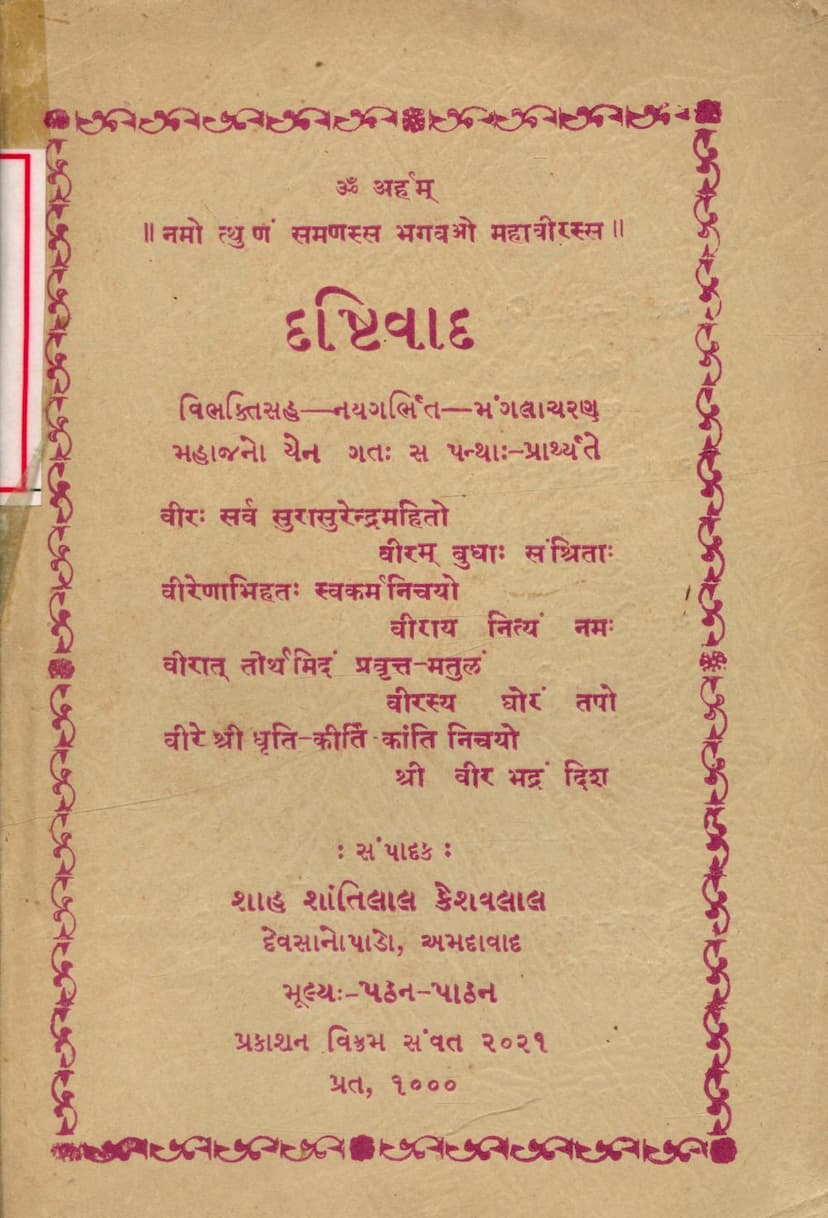Drushtivad
Added to library: September 1, 2025

Summary
This document is a detailed summary and explanation of the Jain text "Drushtivad" by Shantilal Keshavlal Shah. The book aims to explain 108 topics from a Jain perspective, emphasizing the concept of Syadvada (the doctrine of conditioned predication).
Here's a breakdown of the key aspects covered in the document:
1. Introduction and Purpose:
- The book is dedicated to the Chathurvidha Sangha (the fourfold Jain community).
- The author clarifies that this "Drushtivad" is a metaphorical work and should not be confused with the lost twelfth Anga (part of the Jain canon) called Drishtivada.
- The primary goal is to provide knowledge about the purity and impurity of 108 subjects from the Syadvada perspective, based on the teachings of learned ascetics.
- The author humbly requests corrections from scholars if any errors are found due to their limited intellect.
- The book is intended for all individuals who approach it without prejudice.
2. The Six Perspectives (Drishtis):
The book systematically analyzes 108 subjects through six different perspectives or viewpoints, categorized as:
- Vakradrishti (Crooked/Faulty View): Describes individuals with flawed means, leading to negative outcomes.
- Ekantdrishti (One-sided/Absolute View): Describes individuals who are deficient in their ultimate goal (the "saadhya"), leading to futile pursuits of temporary pleasures.
- Visamvadidrishti (Conflicting/Inconsistent View): Describes individuals who are flawed in both means and goals, leading to constant confusion.
- Avakradrishti (Uncrooked/Balanced View): Describes individuals who are pure in their means, extracting the essence (virtue) from everything and achieving good results.
- Anekantdrishti (Many-sided/Relativistic View): Describes individuals who are pure in their goals, achieving increasing purity of their soul and advancing in virtues.
- Avisamvadidrishti (Non-conflicting/Perfect View): Describes individuals who are pure in both means and goals, quickly attaining complete results.
The first three perspectives are considered negative and should be abandoned, while the latter three are positive and should be strived for.
3. Structure and Content:
The book is structured to systematically explain Jain principles:
- The Nature of Reality (Upad-Vyay-Dhruva): The fundamental Jain concept of creation, destruction, and permanence is discussed in relation to the six Drishtis.
- Navatattva (Nine Fundamentals): It details the nine core principles of Jainism: Soul (Jiva), Non-soul (Ajiva), Merit (Punya), Demerit (Pap), Influx (Ashrav), Stoppage (Samvar), Cauterization (Nirjara), Bondage (Bandh), and Liberation (Moksha). Each is analyzed from the six perspectives.
- Navapad (Nine Supreme Beings/Entities): This section covers the five supreme beings (Arihant, Siddha, Acharya, Upadhyaya, Sadhu) and the three jewels of Jainism (Samyak Darshan, Samyak Gyan, Samyak Charitra), along with Tapas (asceticism), also analyzed through the six Drishtis.
- Types of Souls (Bahir-atma, Antar-atma, Param-atma): The three states of the soul are explained.
- Tattva Trayi (Threefold Truths): God (Deva), Guru, and Dharma are elaborated upon.
- Dvidha Yati Dharma (Twelve Aspects of Asceticism): Specific virtues like forgiveness, humility, straightforwardness, contentment, asceticism, self-control, truthfulness, purity, non-possession, and celibacy are detailed.
- Adho Dha Stana (Eighteen Types of Sins): The text lists and explains 18 cardinal sins, including violence, falsehood, theft, illicit sexual intercourse, possession, anger, pride, deceit, greed, passion, hatred, quarrel, slander, gossip, enjoyment/displeasure, backbiting, false speech, and the "thorn" of false belief.
- Matibhed (Types of Perception): Distinguishes between Samyak Mati (right perception) and Mithya Mati (wrong perception).
- Lakshana of Samyaktva (Characteristics of Right Faith): Discusses qualities like tranquility, zeal, detachment, compassion, and faith.
- Shat Shraddha Sthana (Six Principles of Faith): Explains the foundational beliefs: the existence of the soul, the soul's eternality, the soul as the doer of actions, the soul as the experiencer of actions, the possibility of liberation, and the path to liberation.
- Shad Avashyak (Six Essential Duties): Details practices like Samayika (equanimity), Chaturvishati Stava (praise of the twenty-four Tirthankaras), Vandan (obeisance), Pratikramana (confession/atonement), Kaussarga (standing in meditation), and Pachakhyana (vow/abstinence).
- Pancha Yoga Sthana (Five Types of Concentration): Discusses various forms of mental focus.
- Pancha Samavaya Karana (Five Concurrent Causes): Examines the role of Time, Destiny, Nature, Past Actions, and Effort.
- Four Types of Purushartha (Human Endeavors): Dharma, Artha, Kama, and Moksha are discussed.
- Four Types of States (Satta): Royal, Karmic, Dharmic, and Soul states are explored.
- Four Types of Meditation: Art, Raudra, Dharma, and Shukla meditations are explained.
- Threefold Path (Ratnatrayi): Right Faith, Right Knowledge, and Right Conduct are detailed.
- Prakirna Vishay (Miscellaneous Topics): Violence, non-violence, Dharma, Adharma, Right Conduct, Unethical Conduct, Truth, Welfare, and Beauty are analyzed.
4. Philosophical Exposition:
- The book delves into the subtle nuances of Jain philosophy, particularly the Anekantavada perspective.
- It emphasizes that reality is multifaceted and that a single viewpoint cannot fully grasp it.
- The importance of proper understanding of "causes and effects" (hetu-hetumat) is highlighted.
- The role of karma and its impact on the soul is a recurring theme.
5. Author's Intent and Acknowledgements:
- The author expresses gratitude to his teachers and spiritual guides who inspired and supported him in writing this work.
- The book is presented as a humble attempt to clarify complex Jain teachings.
6. Glossary of Terms:
- The document implicitly explains many Jain terms through their contextual usage and the six different interpretations provided for each concept.
In essence, "Drushtivad" by Shantilal Keshavlal Shah is a comprehensive guide that uses the framework of the six perspectives to elucidate various aspects of Jain philosophy and practice, aiming to provide a balanced and comprehensive understanding for the reader.